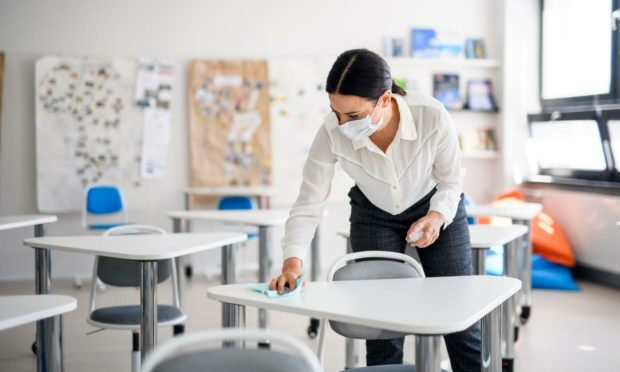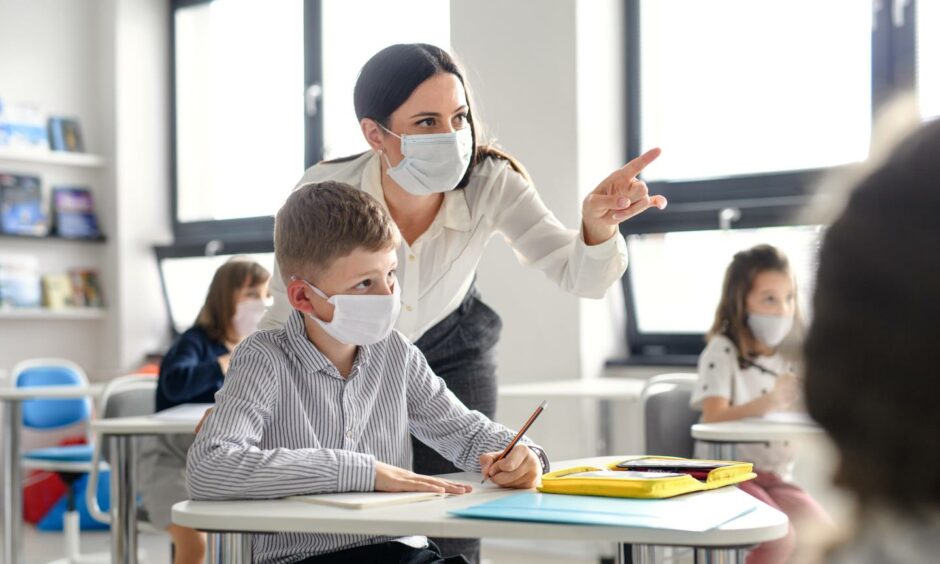A new study found that teachers were not at a higher risk of getting seriously ill from Covid-19 or going to hospital than other working-age adults during the 2020-21 school year.
The study, led by researchers from Glasgow University in cooperation with Public Health Scotland, reviewed Scottish data from March 2020 – July 2021.
It compared the risk of hospitalisation or severe Covid-19 among teachers, and their household members, with adults of working age in the general population.
Although teachers were at a higher risk of needing hospital care while schools were open than when they were closed, they were never at a higher risk than the other working groups.
And throughout the study period, the overall risk of hospitalisation remained less than 1% for teachers, healthcare workers, and adults of working age in the general population.
Teachers not at higher risk than others, even when schools are open
The new study found that “neither teachers nor their household members were at increased risk of hospital admission with Covid-19 or severe Covid-19 at any time during the 2020-21 academic year, when compared with similar working-age adults.”
The study defined a severe case of the virus as one that required admission to the intensive care unit or proved fatal.
Schools were closed during the spring and summer of 2020 and the winter of 2021. During both lockdowns, teachers and their household members were at a 50% lower risk of hospitalisation than the general population. During this same period, patient-facing healthcare workers were at four times the risk of the general population.
This is likely to be broadly reassuring for people involved in face-to-face teaching.”
-Prof David McAllister
When schools were back in session in autumn 2020, the risk of hospital admission in teachers reached a level almost even with the general population. There was a smaller increase during the re-openings in spring 2021, when the delta variant was already circulating.
The study also found that both teachers and their household members were not at higher risk of severe Covid-19 at any time in the 2020-2021 study period.
Why were teachers not at a higher Covid-19 risk?
Lead author Prof David McAllister said that the study can’t say for sure why the risk to teachers was so low while schools were closed. It could be because they had less contact than average adults at the time, he said.
But he said the risk rates while schools were open do paint a useful picture.
“What we can say, is that while schools were open, teacher’s risk of hospitalisation with Covid-19 was about average when compared to that of other working-age people in Scotland who were similar in terms of age, sex, and known underlying medical conditions. This was also true during the recent spike of infections due to the delta variant which occurred when schools were fully open.”
‘Reassuring’ findings for teachers and families
He said that the study should be “broadly reassuring for people involved in face-to-face teaching.”
But, he added, there were important factors among teachers that may have kept their risk level low.
“It is important to note that during the period where the delta variant was circulating, uptake of vaccination among teachers was high, and we would continue to encourage everyone offered a vaccine to take this up.”
Approximately 80% of the teachers studied were women, and most were young, at an average age of 42. The study also found that 84% has no existing conditions – such as heart disease or asthma – that might make a Covid-19 case more severe.
Keep the numbers in context
Prof McAllister added that it is important to keep the numbers in context. Even when hospitalisation risks among teachers more than doubled with schools in session, the overall rate stayed below 1%. The same was true for the general population.
“Most working-age adults are at very little risk of being hospitalised with Covid-19.”
Community restrictions have eased since last school year, after the move Beyond Level 0 in August. And schools are continuing to deal with the spread of the delta variant in communities. But Prof McAllister said he feels confident that the study’s findings provide an accurate and useful picture.
“There was a big surge of the delta variant in Scotland during the study period. And I think that those findings from June probably pretty well captured what it’s like to be in a school with high rates of delta in the community.”
Read more from the Schools & Family team
IN DEPTH: How the Covid cases break down in Highland schools – and what counts as an outbreak
Outdoor learning: Why schools are breaking out of the classroom and into the real world
World record breaking Paralympian Neil Fachie backs Ellon Wheel Park

